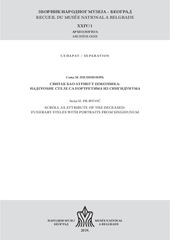Приказ основних података о документу
Svitak kao atribut pokojnika: nadgrobne stele sa portretima iz Singidunuma
| dc.creator | Pilipović, Sanja | |
| dc.date.accessioned | 2023-03-07T10:20:50Z | |
| dc.date.available | 2023-03-07T10:20:50Z | |
| dc.date.issued | 2020 | |
| dc.identifier.issn | 0352-2474 | |
| dc.identifier.uri | http://rai.ai.ac.rs/handle/123456789/483 | |
| dc.description.abstract | Scroll (rotulus, volumen) had not been often represented as an attribute of the deceased on the funerary steles at the limes of the Upper Moesia province. Therefore, it is significant that it was represented on three steles with portraits from Singidunum. On the monumenterected to his wife Larsinia Ingenua by P. Aelius Dionysius ,veteran and signifer of the IV Flavia legion, is depicted married couple in the dextrarum iunctio pose and the husband was represented holding the scroll (IMS I, 35). In the relief on the stele with double epigraphic panel are depicted two female figures, Domitia Ursa and Serenia Quarta, whose names are mentioned in the inscription (IMS I, 52). One of them most probably holds the scroll and the other some object resembling it. Also, in the relief with portraits of married couple carved on today fragmentary preserved stele, the male figure holds the scroll in his hand (IMS I, 62). Besides declaring belonging to the educated and cultural social class and emphasizing the social status, the scroll on these steles had more complex context. It is possible that on the stele of Larsinia Ingenua scroll in the hand of (her husband) veteran of Greek origin P. Aelius Dionysius should have emphasized the idea stated by the dextrarum iunctio gesture, i.e. final farewell of the couple, but it also declared the relatively significant position of this veteran. Scroll in the hand of one woman on stele with double epigraphic panel was intended to emphasize the social status of the portrayed woman and her belonging to the sphere of culture. Third stele was unfortunately preserved only in fragments and does not make possible more precise conclusions. Scroll, as we can see, had very complex role in the integrated system of iconography and inscriptions on the funerary monuments. Although it is often difficult to define precisely its symbolic meaning as an attribute a scroll is exceptionally important element in understanding the image, which the deceased wanted to emphasize by the portrait on his funerary monument. | sr |
| dc.language.iso | sr | sr |
| dc.publisher | Narodni muzej Beograd | sr |
| dc.relation | info:eu-repo/grantAgreement/MESTD/Basic Research (BR or ON)/177012/RS// | sr |
| dc.rights | openAccess | sr |
| dc.source | Zbornik Narodnog muzeja - Arheologija | sr |
| dc.subject | scroll | sr |
| dc.subject | funerary stele | sr |
| dc.subject | portrait | sr |
| dc.subject | Singidunum | sr |
| dc.title | Svitak kao atribut pokojnika: nadgrobne stele sa portretima iz Singidunuma | sr |
| dc.type | article | sr |
| dc.rights.license | ARR | sr |
| dc.citation.epage | 188 | |
| dc.citation.issue | 24/1 | |
| dc.citation.spage | 169 | |
| dc.identifier.fulltext | http://rai.ai.ac.rs/bitstream/id/1217/bitstream_1217.pdf | |
| dc.identifier.rcub | https://hdl.handle.net/21.15107/rcub_rai_483 | |
| dc.type.version | publishedVersion | sr |


